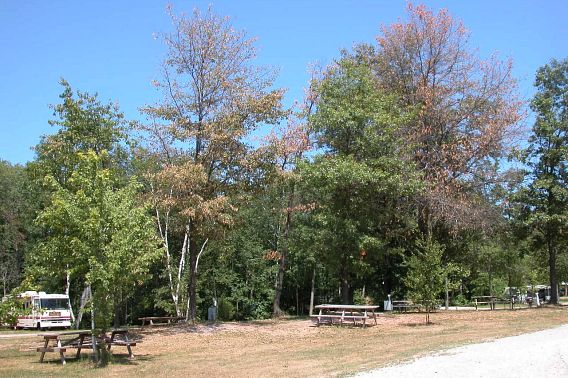Contact: Paul Cigan, DNR Plant, Pest and Disease Specialist
Paul.Cigan@wisconsin.gov or 715-416-4920
Help Protect Oak Trees From Oak Wilt
Hold Off On Pruning Until After July
 Photo credit: Wisconsin DNR
Photo credit: Wisconsin DNR
MADISON, Wis. – The Wisconsin Department of Natural Resources (DNR) reminds everyone that the arrival of spring brings a high risk for the often-fatal oak wilt disease across the state. The DNR recommends not pruning or cutting oak trees from April through July.
In spring and early summer, pruning and cutting oaks leaves them vulnerable to oak wilt, which rapidly kills trees in the red oak group and weakens those in the white oak group. Sap-feeding beetles spread the disease between oaks by carrying oak wilt spores from infected trees or firewood to fresh, exposed tree wounds. Healthy oaks and freshly cut oak stumps can become infected as quickly as 15 minutes after a pruning or broken branch.
As of March 2023, oak wilt has been found across Wisconsin except in Ashland, Iron, Taylor, Door, Kewaunee, Calumet and Manitowoc counties.
“We have seen a lot of tree damage from winter storms that brought heavy snowfall and ice accumulations, causing stems to snap and branches to break and leaving trees completely bent over in some areas of the state,” said Paul Cigan, DNR Forest Health specialist. “While spring cleanup is key to keeping access routes clear and wildfire risk low, it can introduce oak wilt infection in oaks that are cut, pruned, or injured. So it’s important to work with care, whether in the yard or forest.”
DNR pathologist Kyoko Scanlon forecasts the possibility of a brief delay to the start of the oak wilt high-risk period this spring. “We know that cool weather can delay the emergence of sap-feeding beetles that spread oak wilt, and based on our monitoring at this point, it appears we are on track for one of those springs,” said Scanlon.
The slower spring warmup provides a great opportunity for those wishing to clean up yards, trails and forests of fallen debris before the oak wilt risk becomes too high.
Although tree paint or wound dressing is not normally recommended on pruned or wounded surfaces, a light application of these products immediately after an oak is damaged or cut may be the only defense against oak wilt infection during this high-risk period. If possible, apply within 15 minutes. Wounds are susceptible to oak wilt for 72 hours.
Check with your municipality to find out if they have their own oak wilt ordinances that you should follow. It’s also important to note that oak wilt and other diseases move easily on or in firewood logs year-round. Keeping firewood local or purchasing Wisconsin-certified firewood is another key component of protecting trees and maintaining healthy forests.
More information is available on the DNR’s oak wilt webpage.

